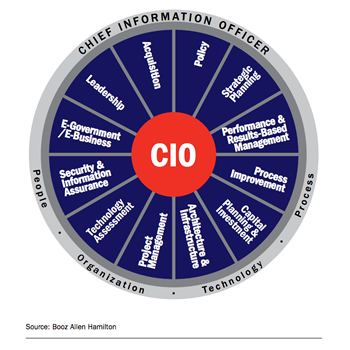Historically, the perception of the role of a Chief Information Officer was viewed synonymously within the silo of IT services. Things have dramatically changed in recent years. These days, CIO’s are required to have expertise in a wide array of areas ranging from project management, innovation management and strategy and customer service.
However, as the role has gotten more complex and plays a larger role in the overall success of the company, the CIO is exposed to more diverse types of challenges within their daily activities. Here is an overview of some of the top challenges that the modern CIO must address to ensure that their job is done correctly and viewed as a success.
Integration of IT into Business Strategy
The CIO and IT department(s) have evolved from primarily taking specific directives, to being much more involved with the overall strategy of the business. With these increased demands, the CIO must have the capability to simultaneously be tech-savvy as well as strategically focused on the impact that IT will have on the overall organization moving forward.
More CIOs are playing a major role in executive-level discussions and decisions. According to a recent study by McKinsey & Company, “When CIOs plan an active role in business strategy, IT performance on a wide range of functional and business tasks improves. The results suggest that closing the gap to engage more CIOs in strategy discussions could deliver business benefits and address widespread concerns over IT effectiveness.”
IT Services Inventory and Personnel Assessment
One of the CIO’s main roles still entails having a strict handle of the types of IT services that their department handles, as well as aligning those with key customer needs. These services may or may not be associated with each other, so having the proper documentation, process and inventory is essential.
As such, the CIO must identify and get buy-in from the various individuals who are involved in the organization’s hierarchy such as IT managers, Engineers, Project Managers and other Key Executive Stakeholders. Managing this array of individuals can prove to be a difficult task with the increased complexity of IT initiatives and wide array of projects company-wide.
As a result, the CIO must establish routines among their employees and external partners. It’s essential to get firm processes in place to make sure that key personnel are aligned with common goals and can collaborate and communicate to hit the desired result. Philosophies like Agile Software Methodology have exploded in recent years, and have provided a very viable solution to keep teams aligned. However, the process itself must be managed, and that often comes back as an additional responsibility for CIOs to oversee.
Personal Capital and Staff Development
The need for multi-faceted staff members has grown, and these individuals are very highly sought after. Also, highly qualified IT professionals are expensive, so to get the right people, a CIO may have to juggle between budget constraints and the need to get the job done. Many reach out to IT-specific staffing firms to provide the necessary pool of candidates.
While there are certain challenges to hiring qualified external individuals who can bring value to the organization, there is increased focus on retaining and developing the talent that is already in house. The CIO is often tasked with IT employee retention plans, plus training programs to cultivate new talent from within the company. This responsibility is paramount, as it is tough to have a robust IT team if there is a high amount of attrition.
Fortunately, there are some strategies that are increasingly being utilized to mitigate some of the attrition and recruiting challenges. CIO’s have started to view IT outsourcing and staff augmentation as a very viable alternative to internal staffing needs. In addition to giving them the ability to get immediate access to talent, it also offers them the opportunity to quickly scale their team up and down depending on the level of work or projects on the table.
The CIO world has recently become increasingly more complex. While the number of responsibilities continues to increase, there are also real challenges from a human capital and communications perspective. However, for those CIOs talented enough to manage the entire process successfully, the payoffs can be very significant.


